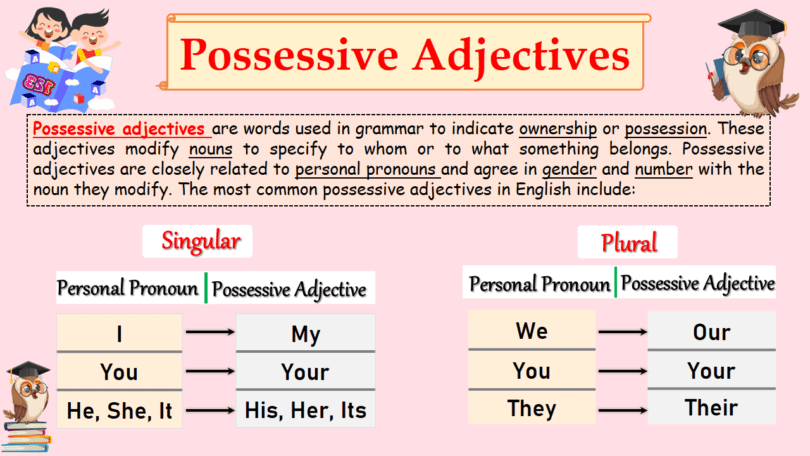Possessive adjectives like ‘my, your, and his show ownership. They make sentences clearer and more interesting. This blog explains what possessive adjectives are, why they are important, and provides examples. It’s simple and easy to understand, perfect for students learning English or anyone wanting to learn more about these words.
What is a Possessive Adjective?
A possessive adjective is a word that tells us who something belongs to. It always comes before a thing or a person to show ownership.
Example Words:
- my, your, his, her, their, its, our, whose
Example Sentences
- This is my ball.
- Her house is larger than your house.
- Will you be going to his birthday party?
- Have you seen our new website?
Subject Pronouns and their Possessive Adjectives:
| Subject Pronoun | Possessive Adjective |
| I | my |
| You (singular) | your |
| He | his |
| She | her |
| It | its |
| We | our |
| You (plural) | your |
| They | their |
Subject pronouns are pronouns that take the place of the subject in a sentence. They indicate who or what is performing the action of the verb.
Possessive Pronouns and their Possessive Adjectives:
| Possessive Pronoun | Possessive Adjective |
|---|---|
| Mine | My |
| Yours | Your |
| His | His |
| Hers | Her |
| Its | Its |
| Ours | Our |
| Yours (plural) | Your (plural) |
| Theirs | Their |
Types of Possessive Adjectives:
Possessive Adjectives can be categorized into three groups based on the person they represent: first person, second person, and third person.
First Person:
The first person is used to refer to the speaker or writer themselves.
Singular:
It is referred to the speaker or writer themselves.
- I went to the store.
- I listened to the music.
Plural:
It is referred to the speaker along with others.
- We enjoyed the movie.
- We played a cricket game.
Second Person:
The second person is used to refer to the person or people being spoken to or written to.
Singular:
It is referred to the person or people being spoken to or written to.
- You should complete your homework.
- You should apply for a job.
Plural:
It is referred to a group of people being addressed.
- Can you all pass me the salt?
- Can you all go to the park?
Third Person:
Third person is referred to individuals or objects that are not the speaker or the person being addressed.
Singular:
It is referred to one individual or object that is not the speaker or the person being addressed.
- He is studying for exams.
- She went to the park.
Plural:
It is referred to multiple individuals or objects that are not the speaker or the person being addressed.
- They completed the project on time.
- They finished their meal on time.
Uses of Possessive Adjective:
1. Showing Ownership:
They indicate that something belongs to someone.
- My book is on the table.
- Our dog is very smart.
2. Describing Relationships:
They show the relationship between people.
- Her brother is very kind.
- Its tale is red.
3. Indicating Parts of Something:
They specify parts of a whole.
-
- He broke his leg.
- She broke her arm.
4. Clarifying Ambiguity:
They help avoid confusion by making it clear who or what you are talking about.
-
- Their car is parked outside.
- Their house is on sale.
Possessive Adjective Examples:
- My cat enjoys sleeping on the windowsill.
- His car is parked in the driveway.
- Our favorite restaurant is closed on Sundays.
- Her laptop is on the kitchen table.
- Their children go to the same school.
- Your jacket is hanging in the closet.
- Its fur is soft and fluffy.
- Our friends are coming over for dinner tonight.
- Your keys are on the counter.
- Their house has a beautiful garden.
You May Also Like






